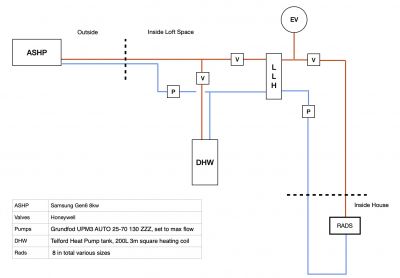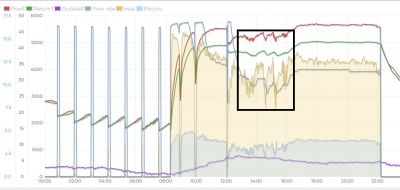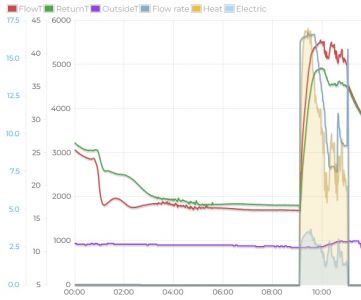Removing a Low Loss Header from Samsung Gen6 System
My system has a low loss header, which for effiency I’d like to remove. Currenlty averaging a daily COP of 3.5 to 3.8, which is good but I’d like it to be better. I have a 8k Samsung gen6, however all the installation information from Samsung or Joule says to use a header or buffer. My system map is this, its fairly simple one zone in two bedroom mid terrace.
Those of you with Samsung gen6 HP do you have a system without a header or buffer, my plan was to just remove it and connect up the flow and returns and see what happens. I just want to make sure I’m not doing something catastrophic before its done.
Samsung Gen6 8kw ASHP in a two bed victorian mid terrace.
Hi
I have a Samsung Gen6 (5kW) running without a LLH or buffer etc. I basically followed Glyn Hudson's tutorial on Youtube. It works fine for me. I guess you need to investigate why they decided to put one in in the first place.
Heatgeek states the reasons for doing it as "High flow rate requirement in the system, high resistance across the system/boiler pump is too small, or multiple heat sources for the property". the link is here https://www.heatgeek.com/low-loss-headers/.
I would imagine the middle one is most applicable to you, so you need to be looking at 28mm pipes to the heat pump itself and then look at the pipe configurations to the rads to make sure they they can carry the heat required at a reasonable flow.Here is a good explanation of that https://youtu.be/1FYv1RnVDrI.
Also check pump sizing. (BTW I dont think your pump supports PWM which is a shame as the heat pump can use it to adjust flow rate automatically, see here https://thegreeningofrosecottage.weebly.com/blog/alls-well-that-ends-well )
As long as your radiators are all open I cant imagine water volume would be an issue, but you could check just to be certain.
House-2 bed partial stone bungalow, 5kW Samsung Gen 6 ASHP (Self install)
6.9 kWp of PV
5kWh DC coupled battery
Blog: https://thegreeningofrosecottage.weebly.com/
Heatpump Stats: http://heatpumpmonitor.org/system/view?id=60
@ecobaker They work reasonably well on open zone, just make sure you always have the minimum flow rate.
Attached is a manual with the open zone programmer settings.
The Samsung DOES NOT support pulse width modulation pump control below 45 Deg Flow temperature, below 45 Deg C it maintains a fixed flow rate of 100%. Not great.
That isnt correct about the PWM Brendon. Here is my Samsung adjusting flow rate below 45C.
House-2 bed partial stone bungalow, 5kW Samsung Gen 6 ASHP (Self install)
6.9 kWp of PV
5kWh DC coupled battery
Blog: https://thegreeningofrosecottage.weebly.com/
Heatpump Stats: http://heatpumpmonitor.org/system/view?id=60
@bontwoody @heacol I'm not sure my system supports modulation either way.
My pumps are UMP3 AUTO, with flow rate setting buttons on them, both currently set to max flow rate, so the heat pump cant modulate them. The secondary pump is permanently on and the primary pump switches on and off controlled by the heat pump. My flow rate round the system when heating is 26 lpm, appropriate for what Samsung recommends. I think my rate could be lower if I've done my maths right, around 16lpm. I could manually reduce the flow rates of the pumps and see what happens. I think my DeltaT is only about 2 degrees currently. Although I don't have very accurate monitoring.
The volume of my system is over 48 litres just in the radiators, so I am well with in minimum requirments for the 8kw pump.
Samsung Gen6 8kw ASHP in a two bed victorian mid terrace.
@bontwoody That flow temperature is pretty close to 45 Deg C (43 deg C), it could be sensor drift that is causing the activation, it is clear that it is not activated at lower temperature. I have seen the official documentation, not publicly available. It is a great shame, as it has a detrimental effect on the performance of the refrigerant circuit. Possibly something to do with the finding that they become very unstable below 30 Deg C flow temperature.
I would be more concerned about the control strategy of the heating system, 45 Deg Flow temperature at 5+ ambient temperature? COP +- 3.5, pretty dismal. (unless you did this as a demonstration or hot water production)
In the middle of renovating an old stone cottage and both my wife and I like it hot inside so higher than desirable flow temperature at the moment. Should improve next winter now I have finished insulating and radiator upgrades to the new living room. Still beating gas though.
@Iancalderbank pointed me to the PWM control possibility and I think he has an 8kW Samsung model. Here is the pump modulation again at a lower flow temperature of about 41C. Perhaps Ian can add to the data available.
House-2 bed partial stone bungalow, 5kW Samsung Gen 6 ASHP (Self install)
6.9 kWp of PV
5kWh DC coupled battery
Blog: https://thegreeningofrosecottage.weebly.com/
Heatpump Stats: http://heatpumpmonitor.org/system/view?id=60
Remove the llh and the secondary pump, wire the pwm line of the primary pump up to the Samsung controller…. That’s pretty much all there is to it.
Off grid on the isle of purbeck
2.4kW solar, 15kWh Seplos Mason, Outback power systems 3kW inverter/charger, solid fuel heating with air/air for shoulder months, 10 acres of heathland/woods.
My wife’s house: 1946 3 bed end of terrace in Somerset, ASHP with rads + UFH, triple glazed, retrofit IWI in troublesome rooms, small rear extension.
@ecobaker ah damn…. Swap that out for a UPM GEO then….
Off grid on the isle of purbeck
2.4kW solar, 15kWh Seplos Mason, Outback power systems 3kW inverter/charger, solid fuel heating with air/air for shoulder months, 10 acres of heathland/woods.
My wife’s house: 1946 3 bed end of terrace in Somerset, ASHP with rads + UFH, triple glazed, retrofit IWI in troublesome rooms, small rear extension.
Yes, just make sure you have the correct flow rate at all times.Posted by: @hughfRemove the llh and the secondary pump, wire the pwm line of the primary pump up to the Samsung controller…. That’s pretty much all there is to it.
- 26 Forums
- 2,396 Topics
- 54.3 K Posts
- 344 Online
- 6,077 Members
Join Us!
Worth Watching
Latest Posts
-
RE: Vaillant aroTherm not heating with many faults
@anon67 when was it last serviced? 1st thing to do is s...
By ASHP-BOBBA , 2 minutes ago
-
RE: Rate the quality of your heat pump design and installation
Hello all,I'm new to the forum. Just had an octopus cos...
By razz , 8 minutes ago
-

RE: Predicted Heat Loss & Needs from MCS calcs vs EPC vs actual
Not sure I entirely agree, @benson. In his last post, @...
By Majordennisbloodnok , 17 minutes ago
-

RE: Setback savings - fact or fiction?
Excellent graphics and description Rob…. But to my mind...
By SUNandAIR , 40 minutes ago
-
RE: Heatpunk Floor plan issues
Now I understand why heat geek and others charge for th...
By jamiejones85 , 2 hours ago
-
RE: Recommended home battery inverters + regulatory matters - help requested
The diagram below is a simplified view of the internals...
By Batpred , 12 hours ago
-
RE: Heat pump not reaching flow temperature
@davec Ive had a look at the screenshots. Lots of th...
By JamesPa , 12 hours ago
-
RE: Considering MLCP (Multi-Layer Composite Pipe) for ASHP
OK, TBH I dont know enough about MLCP to comment with a...
By JamesPa , 15 hours ago
-

RE: Power outages and storms: A surprisingly good DNO experience
Agreed, which is no more nor less than a customer shoul...
By Majordennisbloodnok , 17 hours ago
-

RE: Running from backup generaor in powercut?
@batpred In our case, 3 times each day when the Octopus...
By Toodles , 17 hours ago
-
RE: Advice for a novice on Mitsubishi Ecodan 6kW
Hi @sheriff-fatman Cycling at 5C and below is usuall...
By RobS , 18 hours ago
-
RE: New Fogstar 15.5kWh upright solution
@batpred Here's the latest Fogstar ready built pack....
By Bash , 19 hours ago
-
RE: RDSAP10 effect on existing heat pump EPC rating?
@mike-patrick yes, even though the current system is ru...
By Tim441 , 19 hours ago
-
RE: Solis inverters S6-EH1P: pros and cons and battery options
Solis confirmed that the S6 works with a single battery...
By Batpred , 20 hours ago
-
RE: Who has a V2G EV installation
I am wondering if in any V2X, would the car battery eve...
By Batpred , 21 hours ago
-
Fan unit Making terrible noise HELP!!
One of a pair of fan units on an Earth Save Classic II ...
By GutoFfowc , 22 hours ago
-
RE: New Mitsubishi Ecodan 11.2kW installation - L9 errors and maybe more
OK. I think your system, which seems well designed, is...
By JamesPa , 1 day ago
-

RE: Fan is clipping ice build up from the front of unit.
@majordennisbloodnok I’ll not go there thanks! Toodles.
By Toodles , 2 days ago
-
RE: Running my new Nibe ASHP efficiently
I'm new to the forum. Did you get a reply to this last ...
By Mike @ Camelot , 2 days ago








